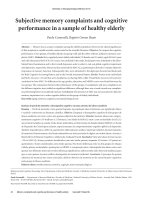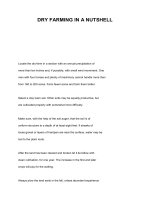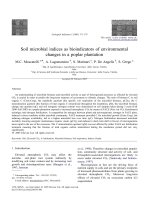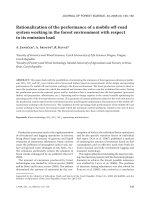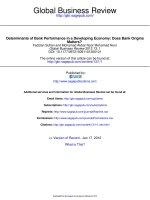Filter system performance in a tilapia recirculating system
Bạn đang xem bản rút gọn của tài liệu. Xem và tải ngay bản đầy đủ của tài liệu tại đây (248.95 KB, 5 trang )
Savin C. et. al./Scientific Papers: Animal Science and Biotechnologies, 2012, 45 (2)
Filter System Performance in a Tilapia Recirculating System
Cristian Savin1,2, Benone Păsărin 1, Marilena Talpeş2, Gabriel Hoha1, Magdalena Tenciu2,
Elpida Paltenea2, Elena Mocanu2, Adrian Gruber1
1
”Ion Ionescu de la Brad” University of Agricultural Sciences and Veterinary Medicine of Iasi,
700490-Iasi, Mihail Sadoveanu, 3, Romania
2
Institute of Research and Development for Aquatic Ecology, Fishing and Aquaculture
80021-Galaţi, Portului, 54, Romania
Abstract
It is known that recirculating aquaculture systems, although has some advantages, production costs resulting from
these production systems are quite high and is mainly due to the filtration system of technological water. Tilapia is
one of the most important species in world aquaculture, the second production after carp, because of the advantages
it has being reared in any production system: ponds, net-pens, cages, raceways, recirculating systems. Aim of this
study was to evaluate the performance of a filter system in a tilapia recirculating system. Experiments were
conducted during October – December 2011, during which feeding was done only with feed, Nutra category, ageappropriate granulation. Main physical – chemical parameters of technological water were monitored, pH, dissolved
oxygen, nitrite, ammonia and ammonium, both the water entry in the filter and the exit from the filter. Filtration
efficiency varied from 2-3% and up to 50-60%, mainly due to rapid loading of the filter and its need for cleaning.
Keywords: aquaculture, filter system, recirculating system, tilapia.
1. Introduction
growth potential of the industry. It is known that
recirculating aquaculture systems, although has
some advantages, production costs resulting from
these production systems are quite high and is
mainly due to the filtration system of
technological water.
The main technical goal to be achieved in a
recirculating aquaculture system is to ensure
environmental conditions that meet, in a larger
measure, eco-physiological peculiarities of the
rearing species. A classical filter unit, within a
recirculating aquaculture system is a combination
of a solids removal (mechanical filtration, gravity
separation), control of gas (oxygen addition, CO2
degassing) and biological processes (nitrification
of ammonia with a biofilter, UV treatment).
Control of physico-chemical parameters is one of
the benefits of recirculating systems [2, 3].
To maintain a clean environment in recirculating
systems, a combination of mechanical and
biological filtration techniques must be employed.
Tilapia represents one of the most reared species
in the world, reaching second place, at this
moment, after carp. This evolution its due, mainly,
because of nutritional meat quality, her easy
reared, especially that is suitable for any
production system: ponds, net-pens, cages,
raceways, recirculating systems and for very good
growth rate. Given that tilapia is a warm water
species, in conditions of Romanian aquaculture
cannot be raised outside all year, except in areas
with hot springs or areas receiving hot water from
various technological processes from industry is
necessary to develop tilapia recirculating systems.
In addition to water conservation, recirculating
systems allow large fish yields to be obtained in a
relatively small area and provide year-round
production [1]. Both attributes increase economic
*Corresponding author: Cristian Savin,
Tel: 0749249030, Email:
102
Savin C. et. al./Scientific Papers: Animal Sciences and Biotechnologies, 2012, 45 (2)
Aim of this study was to evaluate the performance
of a filter system in a tilapia recirculating system,
mainly from nitrogen compounds point of view,
knowing that the most important factor to be
controlled in intensive aquaculture is TAN (total
ammonia nitrogen). Total ammonia nitrogen
(TAN) is the product of bacterial decomposition
of organic waste solids in the system, and includes
two forms unionized ammonia (NH3), very toxic,
and ionized ammonia (NH4+).
Recirculating aquaculture system, used in this
experiment, is represented by an aquarium type
tank with a technological water flow of 1 cubic
meter/hour, and consists of Rearing tank –
represented by a glass aquarium with a water
volume of 0.2 mc; Filter system – Fluval 404
type,composed from: mechanical filter - sponge,
chemical filter – activated charcoal and biological
filter – plastic and ceramic balls; Aeration system
– represented by an air pump ELITE 802 type,
with a water flow of 2 l air/minute at a pressure of
3.5 PSI; and Heating system – represented by a
two thermometers RESUN THERM 25/3000 –
RH 9000 type with a power of 150 W. Rearing
system is represented schematically in Figure 1.
2. Materials and methods
Experiments were conducted at the Institute of
Research and Development for Aquatic Ecology,
Fishing and Aquaculture Galati, from October to
December 2011.
Water heater
Conduct for distribution
of technological water
Biological filter –
ceramic balls
Biological filter –
plastic balls
Air pump
Rearing tank
Chemical filter –
activated
charcoal
Mechanical filter
– sponge
Filtering unit
Water cycle in
filtering unit
Figure 1. Rearing system scheme used in the experiment (filter system in the right)
At the start of experiments, rearing system was
populated with Nile tilapia (Oreochromis
Niloticus L.) with average body weight of 8 g/fish.
Fish was fed, throughout the experimental period,
with Nutra extruded feed (from Skretting), Classic
K 1P, 3 mm grain size and a main biochemical
composition of 43% crude protein, 11.5% lipids,
4% crude cellulose and 7.5% ash. Frequency of
feed was 2 times per day, respectively 08.0 and
16.00; the amount administered being between 1.5
- 2% of fish biomass in 24 hours.
Samples for analyses were collected using plastic
containers, the main physico-chemical parameters
monitored were pH (upH), dissolved oxygen
(mg/l), nitrites (NO2-N - mg/l), ammonia (NH3 mg/l) and ammonium (NH4 - mg/l). For a fair
assessment of filter system, samples were
collected both the water inlet filter system and on
its exit, from the filter system. The total quantity
of ammonia nitrogen was determined by
calculation, analyzing the ammonium nitrogen
compounds and ammonia.
Filter performance was evaluated by [4,5,6]:
a.) calculating the volumetric TAN conversion
rate (VTR) using the formula:
VTR = kc*(TANi - TANe)*Q / Vf ,
where VTR is the volumetric total ammonia
conversion rate (gTAN/m3-day), kc is a conversion
factor of 1.44, TANi is the influent total ammonia
concentration (mg/l); TANe is the effluent total
ammonia concentration (mg/l). Q is the flow rate
through the filter (l/min.), and Vf is the total
volume of the filter medium (m3).
b.) calculating the volumetric nitrite conversion
rate VNR (gNO2/m3-day) using the formula:
103
Savin C. et. al./Scientific Papers: Animal Sciences and Biotechnologies, 2012, 45 (2)
VNR = VTR + kc*(NO2i – NO2e) *Q / Vf ,
where NO2i is the influent nitrite concentration
(mg/l), NO2e is the effluent nitrite concentration
(mg/l) and VTR, kc, Q, and Vf are as defined
previously,
and
c.) calculating the volumetric oxygen consumption
rate OCF (g O2/m3-day) that it indicates the total
amount of bacterial activity within the filter, using
the formula:
OCF = kc*(DOi - DOe) *Q / Vf ,
where DOi is the influent dissolved oxygen
concentration (mg/l), DOe is the dissolved oxygen
concentration in the filter effluent (mg/l) and and
VTR, kc, Q, and Vf are as defined previously.
Also, was evaluated TAN removal efficiency with
the formula:
E = [(TANi – TANe)/ TANi]*100 ,
were E is the TAN removal efficiency capacity
(%),TANi and TANe are as defined previously.
Statistical processing of data obtained was
performed by using descriptive statistics and
ANOVA single factor test in Microsoft Office
Excel utility.
3. Results and discussion
The present research aimed to evaluate filter
system from a recirculating system for rearing
Nile tilapia (Oreochromis Niloticus L.), focusing
on the removal of nitrogen compounds, oxygen
consumption for biological process and influence
on pH.
All parameters analyzed were within acceptable
levels. Values of the main physico-chemical
parameters monitored in the experiment are
presented in the table 1.
Table 1. The main physico – chemical parameters of water influent and effluent from the filter system
Water influent in filter system
Water effluent from filter system
Physico-chemical
parameters
Mean
Mean
Max.
Max.
Min.
Min.
(measure unit)
(± st. dev.)
(± st. dev.)
pH (upH)
7.25
7.43 ± 0.22
7.87
7.37
7.98
7.65 ± 0.22
DO (mg/l)
2.3
4.8
1.19
2.8
3.27 ± 0.69
1.78 ± 0.62
0.0066
0.154
0.0035
0.134
NO2 (mg/l)
0.119 ± 0.07
0.096 ± 0.05
NH3 (mg/l)
0.0012 0.044 ± 0.045
0.107
0
0.068
0.027 ± 0.026
NH4 (mg/l)
0.1
10.287
0.084
8.54
3.44 ± 4.31
2.54 ± 3.48
TAN (mg/l)
0.1017
10.394
0.084
8.59
3.48 ± 4.35
2.56 ± 3.5
concentrations of 0.12 mg/l. Ammonia in water
can have two aspects molecular ammonia
(unionized) and ionized ammonia (NH4+).
Temperature and pH factor determining the
molecular ratio of ammonia to unionized ammonia
in water, the level of acidity having the greatest
influence. With increasing pH factor (low acidity),
total percentage of toxic ammonia in molecular
form, increase logarithmically over the ionized
ammonia. Thus, the amount of total ammonia
nitrogen (TAN) is often used as a limiting factor
of water quality in the design and operation of
intensive aquaculture systems [11]. There are
several technologies available to remove ammonia
nitrogen, but most commonly used is biological
filtration [12].
Evolution of the TAN in the water influent and
effluent from the filter system is showed in the
Figure 2.
Whitin the recirculating total ammonia nitrogen
(TAN) decreased from 3.48 ± 4.35 mg/l (influent)
to 2.56±3.5 mg/l (effluent). Mean recorded
significant differences (p<0.05) between the two
sampling points, while the values obtained in each
of the two points did not vary significantly (p>
0.05).
From a statistical viewpoint, ammonia levels
differ significantly between them (p<0.05) both in
the sampling point, while ammonium ion values
showed no significant differences in any of
sampling points.
One of the critical processes in a recirculating
aquaculture system, and is a key objective in its
design, is the removal of ammonia from water [3,
7, 8, 9, 10]. Ammonia is toxic in molecular form;
only low levels of 0.01 mg/l resulted in sub-lethal
toxic effects (underdeveloped gills, growth slowed
or stopped) in salmon and trout populations, while
european catfish showing symptoms at
104
Savin C. et. al./Scientific Papers: Animal Sciences and Biotechnologies, 2012, 45 (2)
TAN removal efficiency ranged from 2.7% to
55.45% with a mean of 27.5% which is lower than
the value registered by author–60%, in the
researches for doctoral thesis, testing another type
of filter system. Evolution of TAN removal
efficiency is presented in Figure 4.
Figure 2. Evolution of TAN in water influent and
effluent from the filter system
Performances of filter system, to remove the most
important water parameters–nitrogen compounds,
have been evaluated through volumetric TAN
conversion rate (VTR), volumetric nitrite
conversion rate (VNR) and volumetric oxygen
consumption rate (OCF). The values obtained for
VTR ranged from 4g TAN/m3-day to 3.865
gTAN/m3-day with a mean of 1.353g TAN/m3day. These values are more appropriate with those
registered by Stahl et al. [13] in three different
system, 752, 1.014 and 1.190 gTAN/m3-day, and
higher than 300 – 400 gTAN/m3-day of Malone et
al. in 1993 [14] and 600 – 700 gTAN/m3-day of
Thomasson in 1991 [15]. In 1993 Westerman et
al. [16] recorded a value of 100g TAN/m3-day,
which is significant lower of mean registered in
this research. Recommended nitrification rates are
0.7 kgTAN/m3/day for applications in cold water
systems and 1.0 kgTAN/m3/day for warm water
systems [17]. The regression between VTR and
TAN explained 84% variability in VTR (Figure
3).
Figure 4. Efficiency of filter system to remove the
TAN
The values obtained for VNR ranged from 22g
NO2/m3-day to 3.976 gNO2/m3-day with a mean of
1.409 gNO2/m3-day. The overall VNR values
demonstrate higher values than those observed in
similar experiments Wimberly, 1990 [18]; Chitta
1993 [19]; Sastry, 1996 [20]. For example, in
1996, Sastry completed a test with a VNR of 130
gNO2/m3-day. Stahl et al. [13] in 1999 approached
with our results, obtaining in three different
systems values ranged between 503 and 1.539
gNO2/m3-day.
Volumetric oxygen consumption rate (OCF)
ranged from 1.6 kgO2/m3-day to 2.9 kgO2/m3-day
with a mean of 2.2kg O2/m3-day. Wimberly in
1990 [18] and Sastry in 1996 [20] recorded
appropiate value, between 0.7 and 3 kgO2/m3-day.
In Figure 5 is presented evolution of VTR, VNR
and OCF during the entire research.
Figure 3. Regression of VTR versus TAN in
recirculating system – predicted and measured VTR
Figure 5. Evolution of VTR, VNR and OCF
for filter system analyzed
105
Savin C. et. al./Scientific Papers: Animal Sciences and Biotechnologies, 2012, 45 (2)
7. Meade, J.W., Allowable ammonia for fish culture,
Progress in Fish Culture, 1985, 47, 135-145.
8. Avnimelech, Y., Mozares, N., Shaher, D., Kochba,
M., Rates of organic carbon andnitrogen degradation in
intensive fish ponds, Aquaculture, 1995, 134, 211-216.
9. Avnimelech, Y., Carbon/nitrogen as a control
element in aquaculture system, Aquaculture, 1999, 176,
227–235.
10. Kim, S., Kong, I., Lee, B., Kang, L., Lee, M. and
Suh, K., Removal of ammonium – N from a
recirculation aquacultural system using an immobilized
nitrifiers, Aquaculture Engineering, 2000, 21, 139-150.
11. Losordo, T., Westerman, P. W., Liehr, S. K., Water
treatment and wastewater generation in intensive
recirculating fish production system, Bull. Natl. Inst.
Aquaculture, 1994, suppl. 1, 27 - 36.
12. Losordo, T., Masser, M., Rakocy, J., Recirculating
aquaculture tank production systems: An overview of
critical considerations, Southern Regional Aquaculture
Center Publication, 1992, 451
13. Stahl, J.C., Drennan, G.D., Beecher, E.L., Malone
R.F., Enhancing Nitrification in Propeller-Washed
Bioclarifiers with Modified Floating Bead Media, 1999
14. Malone, R. F., Chitta, B.S., and Drennan, D.G.,
Optimizing Nitrification in Bead Filters for Warmwater
Recirculating Aquaculture Systems. In: Wang, J. K.
(Ed.), Techniques for Modern Aquaculture, American
Society of Agricultural Engineers, Michigan, 1993, pp.
315-325.
15. Thomasson, M.P., Nitrification in Fluidized Bed
Sand Filters for Use in Recirculating Aquaculture
Systems. Master’s Thesis, Louisiana State University,
Baton Rouge, Louisiana, 1991, 122 pp.
16. Westerman, P. W., Losordo, T.M., and Wildhaber,
M. L., Evaluation of Various Biofilters in an Intensive
Recirculating Fish Production Facility. In: Wang, J. K.
(Ed.). Techniques for Modern Aquaculture American
Society of Agricultural Engineers, Michigan, 1993, pp.
326-334.
17. Timmons, M.B., Ebeling, J.M., Wheaton, F.W.,
Summerfelt, S.T. & Vinci, B.J., Recirculating
Aquaculture Systems, Cayuga Aqua Ventures, Ithaca,
NY, USA, 2001, pp. 650.
18. Wimberly, D.M., Development and Evaluation of a
Low-Density Media Biofiltration Unit for Use in
Recirculating Fish Culture Systems, Master's Thesis,
Louisiana State University, Baton Rouge, Louisiana,
1990,
19. Chitta, B.S., Effects of Backwash Frequency on the
Nitrification in Plastic Bead Media Biofilters Used in
Recirculating Finfish Culture Systems. M. S. Thesis,
Louisiana State University, 1993, Baton Rouge,
Louisiana.
20. Sastry, B.N., A Comparison of Nitrification
Capacity in Bead and Tubular Plastic Media. M.S.
Thesis, Louisiana State University, 1996, Baton Rouge,
Louisiana.
4. Conclusions
The recirculating system showed a good
performance, at laboratory level, for tilapia rearing
in terms of environment quality. The nitrogen
compounds were very good controlled, despite the
fact that tilapia is a warm water species who need
a higher temperature for rearing, that could
influence ammonia and ammonium.
Volumetric TAN conversion rate (VTR) registered
very good values, whit a mean of 1.353g TAN/m3day, which means that the principle is feasible and
should be tested in larger recirculating systems,
preferably on a commercial scale.
Filtration efficiency ranged between 2-3% and 5060%, with large differences between values, this is
due to the fact that the filter was washed weekly,
but not at regular intervals, which could affect the
accuracy of data achieved.
Acknowledgements
“This work was co-financed from the European Social
Fund through Sectoral Operational Programme Human
Resources Development 2007-2013, project number
POSDRU/I.89/1.5/S62371 ,,Postdoctoral School in
Agriculture and Veterinary Medicine area”
References
1. Van Gorder, S.D., Operating and managing water
reuse systems, In: M.B. Timmons and T.M. Losordo,
editors. Aquaculture water reuses systems Engineering
design and management. Developments in aquaculture
and fisheries science, vol. 27. Elsevier Science,
Amsterdam, 1994, pp. 281-306
2. Heinen, J.M., Hankins, J. A., Weber, A.L., A semiclosed recirculating-water system for high-density
culture of rainbow trout, Prog. Fish Cult.,1996, 58 (1),
1122.
3. Cristea V., Grecu I., Ceapă C., Ingineria sistemelor
recirculante, Galaţi, 2002.
4. Malone, R.F., Beecher, L.E., Use of floating bead
filters to recondition recirculating waters in warmwater
aquaculture
production
systems,
Aquacultural
Engineering, 2000, 22, 57–74.
5. Malone, R.F., Pfeiffer, T.J., Rating fixed-film
nitrifying biofilters used in recirculating aquaculture
systems, Aquacult. Eng., 2006, 34, 389–402.
6. Pfeiffer,
T.J.,
Malone,
R.F.,
Nitrification
performance of a propeller-washed bead clarifier
supporting a fluidized sand biofilter in a recirculating
warmwater fish system, Aquaculture Engineering,
2006, 34, 311-321.
106


